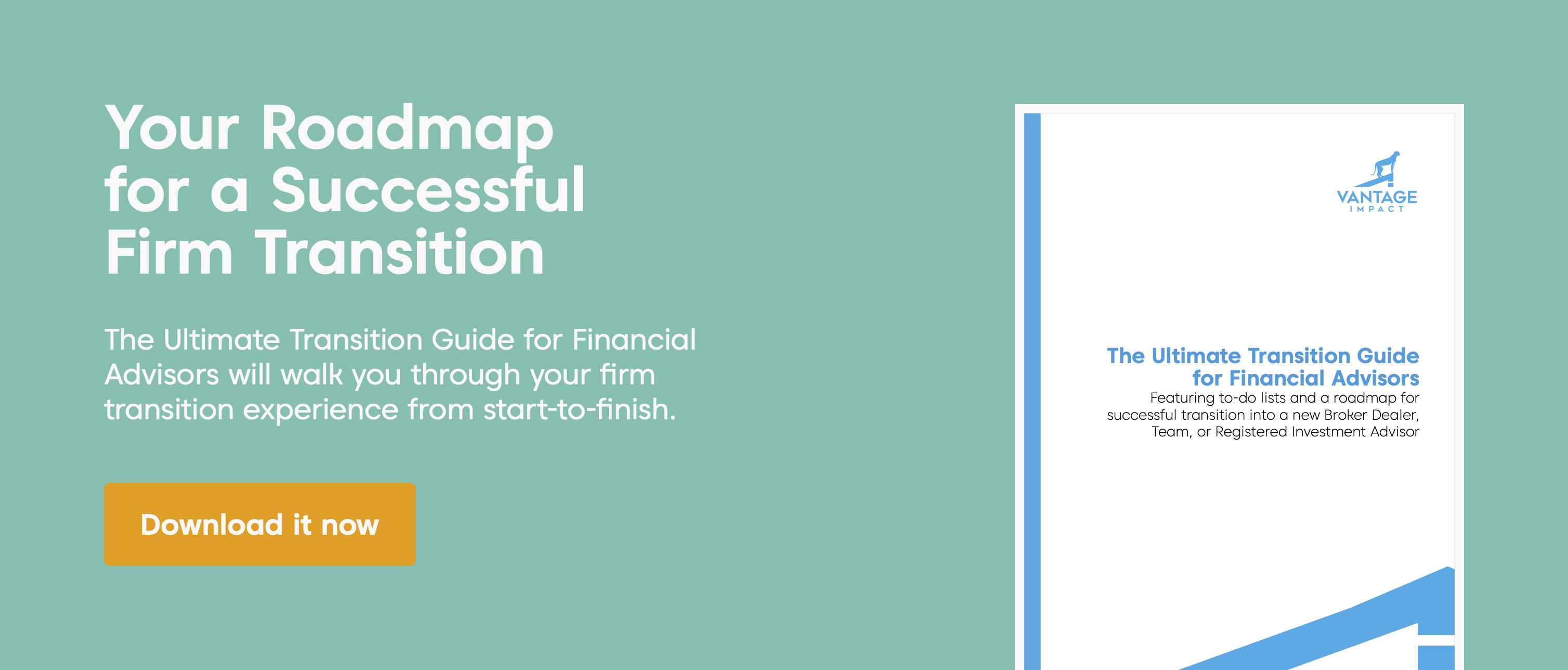The thought of transitioning to a new firm can feel exhilarating, especially for a financial advisor who may feel unsatisfied with their situation, but it can also create anxiety. How do I know that leaving my current firm will be the best thing for my business and my family? If I know that I need to leave my firm, how do I determine which new firm is the “right fit?”
Use these 5 steps to build a roadmap for your decision-making process and analyze what will be best for you and your business. By following the five steps below and implementing a strategic approach, you will feel confident in your next steps.
1. Assess Your Situation
- What value is your current firm providing?
- What is your current firm missing? (Examples: no electronic signature option for new account setup, lack of mobile app for clients, policies against texting with clients, etc.)
- What support do you need from a firm to be able to succeed? (Examples: freedom in product choice, marketing resources, etc.)
2. Review Your Business
- Rep or broker agreement (Documents you signed when you joined your broker dealer)
- Production & asset statements from the last 30-60 days
- Deferred comp statement and upcoming bonus dates/amounts
- Existing promissory note or bonus agreement
- Ticker symbols across the practice
- Consider proactively creating a letter of explanation regarding any past issues that might come up in these documents (Example: items that may be found in BrokerCheck)
Pro Tip:
You may have saved these documents at the time you joined your current firm. If not, you may need to request them from your company. To help collect these documents do this as part of your estate and succession planning.
3. Check in on Your Personal Financial Situation
- Review your credit report.
- Evaluate the utilization amount of your credit cards (Note: credit utilization above 40% can raise questions, and utilization above 80% may indicate future financial issues).
- Through your county clerk or online lien search, check to see if you have any outstanding liens (Note: not addressing open liens, even if filed mistakenly, could cause delays in your re-registration).
- Take small steps to boost your credit score. Ways to do this include:
- Asking your credit card company to increase your credit limit, which helps with your utilization percentage;
- Checking your credit report for any late pays, and get them current; and
- Limiting the number of credit pulls several months before you start talking with any new firms. Chances are each firm you explore will pull your credit, which has an adverse effect on your score.
4. Develop Your List of Questions & Get Organized
- What are the non-starter things a firm must offer in order for you to make a switch?
- What are your high priority items that must be top of mind every step of the way? (Example: client retention / ensuring you don’t lose them during the transition)
- Think about the various parties who may have a say in your decision and develop a plan to incorporate them into your search efforts. Depending on the contract you have in place with your firm, you may be allowed to confer with other people at your firm, or individuals like:
- Business partners;
- Junior advisors;
- Key staffers; and/or
- Spouse or important family decision makers.
- Word of caution: Do not discuss a possible transition with any clients. This can be a huge, costly misstep.
Pro Tip:
For a list of questions you may want to obtain answers to when evaluating firms, click here.
5. Set Goals
- Decide how much time you want to commit to evaluating your options.
- Determine when you want to make your decision.
- Mentally segment your clients and determine who you expect to follow you in your transition.
- Think about what you want to financially accomplish for yourself.
- One-year year advanced retrospective exercise – envision where you see yourself a year from now.
When thinking about the possibility of transitioning to a new firm, a strategic roadmap can assist you in the decision-making process. You can begin to analyze all of the key variables and blaze a path forward confidently doing what is best for your business. Are you looking for a trusted partner to help guide you as you take this next step in your career? Sign up for a free consultation with Vantage Impact today.




